Publications
Highlights
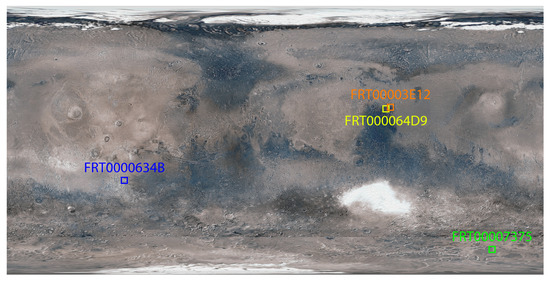
Planetary exploration missions have acquired a growing amount of remote sensing data, offering a reliable basis for studying the geological evolution of planetary bodies such as Mars. In recent years, machine learning models have emerged as powerful tools for remote sensing by providing scalable and adaptive solutions for planetary science. We present a machine learning approach to map the spatial distribution of minerals on Mars, representing a step toward large-scale automated mineral mapping. Although existing CRISM dimensionality reduction methods are useful, the feature space remains high-dimensional, and relying on RGB overlays limits the ability to preserve and detect complex relationships, increasing the risk of missing important spectral patterns. Our framework utilises the Self-Organising Map (SOM) model and k-means clustering to identify clusters of spectral signatures, which may correspond to distinct minerals. It reduces dimensionality to a two-dimensional grid while preserving key high-dimensional patterns and relationships, providing a more reliable and interpretable basis for semi-automated analysis than RGB overlays. Although the clusters can be labelled by referencing a spectral library, our framework does not require labelled data and can operate in an unsupervised manner. The framework retains full spectral dimensionality of input features. The results indicate that our framework can identify the spatial distribution of minerals on Mars, even in complex spectral environments with overlapping features. Moreover, the SOM model output is interpretable rather than a black box, providing intuitive guidance for mineral exploration when applied in a semi-automated workflow.
Tejay Lovelock, Rohitash Chandra
Remote Sens. 2025, 17(21), 3578
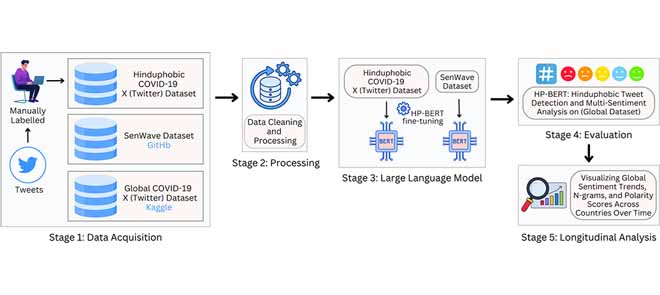
During the COVID-19 pandemic, community tensions intensified, contributing to discriminatory sentiments against various religious groups, including Hindu communities. Recent advances in language models have shown promise for social media analysis with potential for longitudinal studies of social media platforms, such as X (Twitter). We present a computational framework for analyzing anti-Hindu sentiment (Hinduphobia) during the COVID-19 period, introducing an abuse detection and sentiment analysis approach for longitudinal analysis on X. We curate and release a “Hinduphobic COVID-19 XDataset” containing 8,000 annotated and manually verified tweets. We then develop the Hinduphobic BERT (HP-BERT) model using this dataset and achieve 94.72% accuracy, outperforming baseline Transformer-based language models. The model incorporates multi-label sentiment analysis capabilities through additional fine-tuning. Our analysis encompasses approximately 27.4 million tweets from six countries, including Australia, Brazil, India, Indonesia, Japan, and the United Kingdom. Statistical analysis reveals moderate correlations (r = 0.312-0.428) between COVID-19 case increases and Hinduphobic content volume, highlighting how pandemic-related stress may contribute to discriminatory discourse. This study provides evidence of social media-based religious discrimination during a COVID-19 crisis.
Ashutosh Singh; Rohitash Chandra
IEEE Access (Volume: 13), 175309 - 175335, 03 October 2025
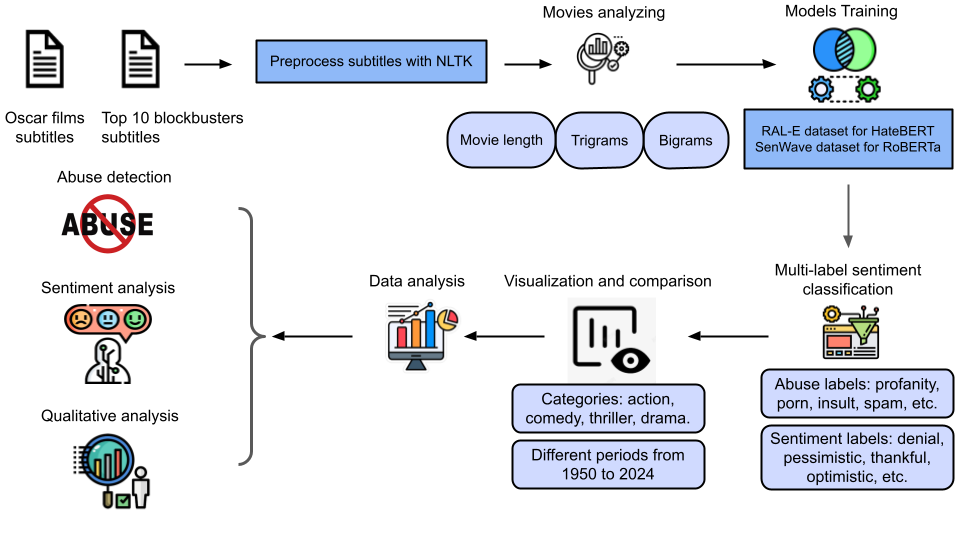
Over the past decades, there has been an increase in the prevalence of abusive and violent content in Hollywood movies. In this study, we use language models to explore the longitudinal abuse and sentiment analysis of Hollywood Oscar and blockbuster movie dialogues from 1950 to 2024. We provide an analysis of subtitles for over a thousand movies, which are categorised into four genres. We employ fine-tuned language models to examine the trends and shifts in emotional and abusive content over the past seven decades. Findings reveal significant temporal changes in movie dialogues, which reflect broader social and cultural influences. Overall, the emotional tendencies in the films are diverse, and the detection of abusive content also exhibits significant fluctuations. The results show a gradual rise in abusive content in recent decades, reflecting social norms and regulatory policy changes. Genres such as thrillers still present a higher frequency of abusive content that emphasises the ongoing narrative role of violence and conflict. At the same time, underlying positive emotions such as humour and optimism remain prevalent in most of the movies. Furthermore, the gradual increase of abusive content in movie dialogues has been significant over the last two decades, where Oscar-nominated movies overtook the top ten blockbusters.
Rohitash Chandra, Guoxiang Ren
Machine Learning with Applications, Volume 22, December 2025, 100749
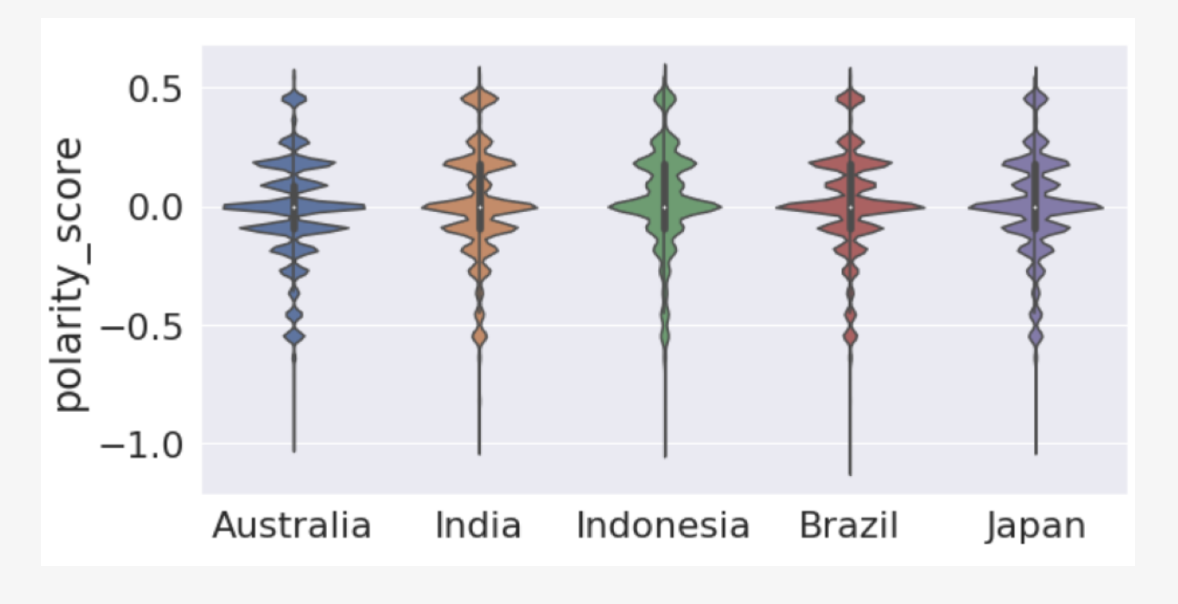
Anti-vaccine sentiments have been well-known and reported throughout the history of viral outbreaks and vaccination programmes. The COVID-19 pandemic caused fear and uncertainty about vaccines, which has been well expressed on social media platforms such as Twitter (X). We analyse sentiments from the beginning of the COVID-19 pandemic and study the public behaviour on X during the planning, development, and deployment of vaccines expressed in tweets worldwide using a sentiment analysis framework via deep learning models. We provide visualisation and analysis of anti-vaccine sentiments throughout the COVID-19 pandemic. We review the nature of the sentiments expressed with the number of tweets and monthly COVID-19 infections. Our results show a link between the number of tweets, the number of cases, and the change in sentiment polarity scores during major waves of COVID-19. We also find that the first half of the pandemic had drastic changes in the sentiment polarity scores that later stabilised, implying that the vaccine rollout impacted the nature of discussions on social media.
Rohitash Chandra, Jayesh Sonawane, Jahnavi Lande
https://doi.org/10.3390/bdcc8120186
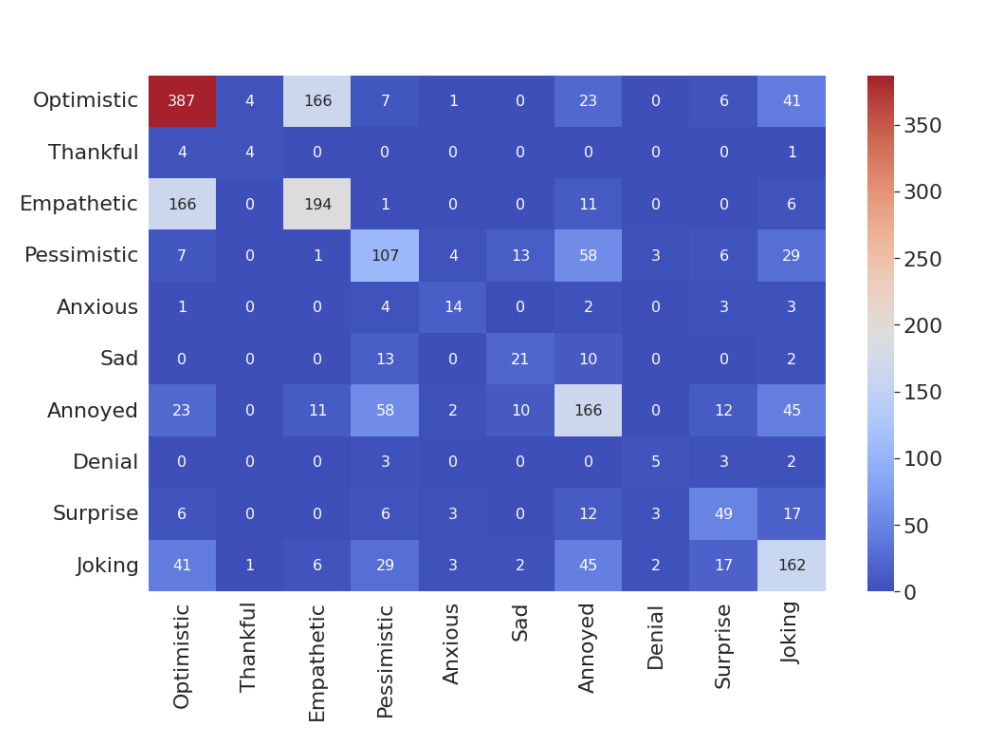
Google Translate has been prominent for language translation; however, limited work has been done in evaluating the quality of translation when compared to human experts. Sanskrit one of the oldest written languages in the world. In 2022, the Sanskrit language was added to the Google Translate engine. Sanskrit is known as the mother of languages such as Hindi and an ancient source of the Indo-European group of languages. Sanskrit is the original language for sacred Hindu texts such as the Bhagavad Gita. In this study, we present a framework that evaluates the Google Translate for Sanskrit using the Bhagavad Gita. We first publish a translation of the Bhagavad Gita in Sanskrit using Google Translate. Our framework then compares Google Translate version of Bhagavad Gita with expert translations using sentiment and semantic analysis via BERT-based language models. Our results indicate that in terms of sentiment and semantic analysis, there is low level of similarity in selected verses of Google Translate when compared to expert translations. In the qualitative evaluation, we find that Google translate is unsuitable for translation of certain Sanskrit words and phrases due to its poetic nature, contextual significance, metaphor and imagery. The mistranslations are not surprising since the Bhagavad Gita is known as a difficult text not only to translate, but also to interpret since it relies on contextual, philosophical and historical information. Our framework lays the foundation for automatic evaluation of other languages by Google Translate
Shukla A; Bansal C; Badhe S; Ranjan M; Chandra R
Full List
QDeepGR4J: Quantile-based ensemble of deep learning and GR4J hybrid rainfall-runoff models for extreme flow prediction with uncertainty quantification
Arpit Kapoor, Rohitash Chandra
Journal of Hydrology, Volume 664, Part B, January 2026, 134434
Unsupervised Machine Learning Framework for Identification of Spatial Distribution of Minerals on Mars
Tejay Lovelock, Rohitash Chandra
Remote Sens. 2025, 17(21), 3578
Convolutional Neural Networks for Mineral Prospecting Through Alteration Mapping with Remote Sensing Data
Ehsan Farahbakhsh, Dakshi Goel, Dhiraj Pimparkar, R. Dietmar Müller & Rohitash Chandra
PFG – Journal of Photogrammetry, Remote Sensing and Geoinformation Science, Volume 93, pages 379–400, (2025)
Pedestrian trajectory prediction using goal-driven and dynamics-based deep learning framework
Honghui Wang, Weiming Zhi, Gustavo Batista, Rohitash Chandra
Expert Systems with Applications, Volume 271, 1 May 2025, 126557
Large language models for newspaper sentiment analysis during COVID-19: The Guardian
Rohitash Chandra, Baicheng Zhu, Qingying Fang, Eka Shinjikashvili
Applied Soft Computing Volume 171, March 2025, 112743
Multi-modal deep learning for credit rating prediction using text and numerical data streams
Mahsa Tavakoli, Rohitash Chandra, Fengrui Tian, Cristián Bravo
Applied Soft Computing Volume 171, March 2025, 112771
An Evaluation of LLMs and Google Translate for Translation of Selected Indian Languages via Sentiment and Semantic Analyses
Rohitash Chandra; Aryan Chaudhari; Yeshwanth Rayavarapu
IEEE Access (Volume: 13), 122386 - 122407, 03 July 2025
HP-BERT: A Framework for Longitudinal Study of Hinduphobia on Social Media via Language Models
Ashutosh Singh; Rohitash Chandra
IEEE Access (Volume: 13), 175309 - 175335, 03 October 2025
Science and Hinduism share the vision of a quest for truth
Rohitash Chandra
Nature Human Behaviour volume 9, pages7–8 (2025)
Longitudinal abuse and sentiment analysis of Hollywood movie dialogues using language models
Rohitash Chandra, Guoxiang Ren
Machine Learning with Applications, Volume 22, December 2025, 100749
An Analysis of Vaccine-Related Sentiments on Twitter (X) from Development to Deployment of COVID-19 Vaccines
Rohitash Chandra, Jayesh Sonawane, Jahnavi Lande
https://doi.org/10.3390/bdcc8120186
Deepdive: Leveraging Pre-trained Deep Learning for Deep-Sea ROV Biota Identification in the Great Barrier Reef
Ratneel Deo, Cédric M. John, Chen Zhang, Kate Whitton, Tristan Salles, Jody M. Webster, Rohitash Chandra
Scientific Data volume 11, Article number: 957 (2024)
Remote sensing framework for geological mapping via stacked autoencoders and clustering
Sandeep Nagar, Ehsan Farahbakhsh, Joseph Awange, Rohitash Chandra
Advances in Space Research, Volume 74, Issue 10, 15 November 2024, Pages 4502-4516
A clustering and graph deep learning-based framework for COVID-19 drug repurposing
Chaarvi Bansal, P.R. Deepa, Vinti Agarwal, Rohitash Chandra
Expert Systems with Applications, Volume 249, Part A, 1 September 2024, 123560
Deep learning framework with Bayesian data imputation for modelling and forecasting groundwater levels
Eric Chen, Martin S. Andersen, Rohitash Chandra
Environmental Modelling & Software, Volume 178, July 2024, 106072
A review of ensemble learning and data augmentation models for class imbalanced problems: Combination, implementation and evaluation
Azal Ahmad Khan, Omkar Chaudhari, Rohitash Chandra
Expert Systems with Applications, Volume 244, 15 June 2024, 122778
A unified machine learning framework for basketball team roster construction: NBA and WNBA
Yuhao Ke, Ranran Bian, Rohitash Chandra
Applied Soft Computing, Volume 153, March 2024, 111298
Sequential reversible jump MCMC for dynamic Bayesian neural networks
Nhat Minh Nguyen, Minh-Ngoc Tran, Rohitash Chandra
Neurocomputing, Volume 564, 7 January 2024, 126960
A Quantum-Inspired Predator–Prey Algorithm for Real-Parameter Optimization
Azal Ahmad Khan, Salman Hussain, Rohitash Chandra
Algorithms 2024, 17(1), 33
Bayesian Neural Networks via MCMC: A Python-Based Tutorial
Rohitash Chandra, Joshua Simmons
IEEE Access, Volume: 12, 70519 - 70549, 15 May 2024
Large Language Models for Metaphor Detection: Bhagavad Gita and Sermon on the Mount
Rohitash Chandra, Abhishek Tiwari, Naman Jain, Sushrut Badhe
IEEE Access, 12, pp. 84452 - 84469
Recursive Deep Learning Framework for Forecasting the Decadal World Economic Outlook
Tianyi Wang, Rodney Beard, John Hawkins, Rohitash Chandra
IEEE Access, 12, pp. 152921 - 152944
ReefCoreSeg: A Clustering-Based Framework for Multi-Source Data Fusion for Segmentation of Reef Drill Cores
Ratneel Deo, Jody M. Webster, Tristan Salles, Rohitash Chandra
IEEE Access, 12, pp. 12164 - 12180
Memory capacity of recurrent neural networks with matrix representation
Animesh Renanse, Alok Sharma, Rohitash Chandra
Neurocomputing, 560
Surrogate-assisted distributed swarm optimisation for computationally expensive geoscientific models
Rohitash Chandra, Yash Vardhan Sharma
Computational Geosciences, Volume 27, pages 939–954, (2023)
Gradient boosting Bayesian neural networks via Langevin MCMC
George Bai, Rohitash Chandra
Neurocomputing, Volume 558, 14 November 2023, 126726
DeepGR4J: A deep learning hybridization approach for conceptual rainfall-runoff modelling
Arpit Kapoor, Sahani Pathiraja, Lucy Marshall, Rohitash Chandra
Environmental Modelling & Software, Volume 169, November 2023, 105831
Deep learning for COVID-19 topic modelling via Twitter: Alpha, Delta and Omicron
Lande J; Pillay A; Chandra R
arxiv:2303.00135 (2023)
Reef-Insight: A Framework for Reef Habitat Mapping with Clustering Methods Using Remote Sensing
Saharsh Barve, Jody M. Webster, Rohitash Chandra
Information 2023, 14(7), 373
Unsupervised machine learning framework for discriminating major variants of concern during COVID-19
Rohitash Chandra, Chaarvi Bansal, Mingyue Kang, Tom Blau, Vinti Agarwal, Pranjal Singh, Laurence O. W. Wilson, Seshadri Vasan
https://doi.org/10.1371/journal.pone.0285719
Bayesian neuroevolution using distributed swarm optimization and tempered MCMC
Arpit Kapoor, Eshwar Nukala, Rohitash Chandra
Applied Soft Computing, Volume 129, November 2022, 109528
CoviRx: A User-Friendly Interface for Systematic Down-Selection of Repurposed Drug Candidates for COVID-19
Hardik A. Jain, Vinti Agarwal, Chaarvi Bansal, Anupama Kumar, Faheem, Muzaffar-Ur-Rehman Mohammed, Sankaranarayanan Murugesan, Moana M. Simpson, Avinash V. Karpe, Rohitash Chandra, Christopher A. MacRaild, Ian K. Styles, Amanda L. Peterson, Matthew A. Cooper, Carl M. J. Kirkpatrick, Rohan M. Shah, Enzo A. Palombo, Natalie L. Trevaskis, Darren J. Creek, Seshadri S. Vasan
Data 2022, 7(11), 164
Evolutionary bagging for ensemble learning
Giang Ngo, Rodney Beard, Rohitash Chandra
Neurocomputing, Volume 510, 21 October 2022, Pages 1-14
Spatio temporal hydrological extreme forecasting framework using LSTM deep learning model
Anshuka Anshuka, Rohitash Chandra, Alexander J. V. Buzacott, David Sanderson, Floris F. van Ogtrop
Stochastic Environmental Research and Risk Assessment, Volume 36, pages 3467–3485, (2022)
Artificial intelligence for topic modelling in Hindu philosophy: Mapping themes between the Upanishads and the Bhagavad Gita
Rohitash Chandra, Mukul Ranjan
https://doi.org/10.1371/journal.pone.0273476
An evaluation of Google Translate for Sanskrit to English translation via sentiment and semantic analysis
Shukla A; Bansal C; Badhe S; Ranjan M; Chandra R
arxiv:2303.07201 (2023)
Physics-informed neural entangled-ladder network for inhalation impedance of the respiratory system
Kumar AK; Jain S; Jain S; Ritam M; Xia Y; Chandra R
Computer Methods and Programs in Biomedicine, vol. 231, pp. 107421 - 107421 (2023)
Cyclone trajectory and intensity prediction with uncertainty quantification using variational recurrent neural networks
Kapoor A; Negi A; Marshall L; Chandra R
Environmental Modelling & Software, vol. 162, pp. 105654 - 105654 (2023)
Deep learning for predicting respiratory rate from biosignals
Amit Krishan Kumar, M. Ritam, Lina Han, Shuli Guo, Rohitash Chandra
Computers in Biology and Medicine, Volume 144, May 2022, 105338
A Comparative Study of Convolutional Neural Networks and Conventional Machine Learning Models for Lithological Mapping Using Remote Sensing Data
Hojat Shirmard, Ehsan Farahbakhsh, Elnaz Heidari, Amin Beiranvand Pour, Biswajeet Pradhan, Dietmar Müller, Rohitash Chandra
Remote Sens. 2022, 14(4), 819
Distributed Bayesian optimisation framework for deep neuroevolution
Rohitash Chandra, Animesh Tiwari
Neurocomputing, Volume 470, 22 January 2022, Pages 51-65
A review of machine learning in processing remote sensing data for mineral exploration
Hojat Shirmard, Ehsan Farahbakhsh, R. Dietmar Müller, Rohitash Chandra
Remote Sensing of Environment, Volume 268, January 2022, 112750
Deep learning via LSTM models for COVID-19 infection forecasting in India
Rohitash Chandra, Ayush Jain, Divyanshu Singh Chauhan
January 28, 2022, https://doi.org/10.1371/journal.pone.0262708
Revisiting Bayesian Autoencoders With MCMC
Rohitash Chandra, Mahir Jain, Manavendra Maharana, Pavel N. Krivitsky
IEEE Access, 10, pp. 40482 - 40495
Semantic and Sentiment Analysis of Selected Bhagavad Gita Translations Using BERT-Based Language Framework
Rohitash Chandra, Kulkarni V
IEEE Access, 10, pp. 21291 - 21315
SMOTified-GAN for Class Imbalanced Pattern Classification Problems
Anuraganand Sharma, Prabhat Kumar Singh, Rohitash Chandra
IEEE Access, 10, pp. 30655 - 30665
Predicting the emplacement of Cordilleran porphyry copper systems using a spatio-temporal machine learning model
Julian Diaz-Rodriguez, R. Dietmar Müller, Rohitash Chandra
Ore Geology Reviews, Volume 137, October 2021, 104300
COVID-19 sentiment analysis via deep learning during the rise of novel cases
Rohitash Chandra, Aswin Krishna
PLOS ONE, 16(8), e0255615
Bayesian neural networks for stock price forecasting before and during COVID-19 pandemic
Rohitash Chandra, Yixuan He
PLOS ONE, 16(8), e0255615
Precipitation reconstruction from climate-sensitive lithologies using Bayesian machine learning
Rohitash Chandra, Sally Cripps, Nathaniel Butterworth, R. Dietmar Muller
Environmental Modelling and Software, 139, pp. 105002
Bayesian geological and geophysical data fusion for the construction and uncertainty quantification of 3D geological models
Hugo K.H. Olierook, Richard Scalzo, David Kohn, Rohitash Chandra, Ehsan Farahbakhsh, Chris Clark, Steven M. Reddy, R. Dietmar Müller
Geoscience Frontiers, Volume 12, Issue 1, January 2021, Pages 479-493
Biden vs Trump: Modeling US General Elections Using BERT Language Model
Chandra R; Saini R
IEEE Access, 9, pp. 128494 - 128505
Evaluation of Deep Learning Models for Multi-Step Ahead Time Series Prediction
Chandra R, Goyal S, Gupta R
IEEE Access, 9, pp. 83105 - 83123
Surrogate-assisted parallel tempering for Bayesian neural learning
Chandra R, Jain K, Kapoor A, Aman A
Engineering Applications of Artificial Intelligence, 94, pp. 103700
Surrogate-assisted Bayesian inversion for landscape and basin evolution models
Chandra R, Azam D, Kapoor A, Dietmar Müller R
Geoscientific Model Development, 13, pp. 2959 - 2979
Integration of selective dimensionality reduction techniques for mineral exploration using ASTER satellite data
Shirmard H, Farahbakhsh E, Pour AB, Muslim AM, Dietmar Müller R, Chandra R
Remote Sensing, 12
Computer vision-based framework for extracting tectonic lineaments from optical remote sensing data
Farahbakhsh E, Chandra R, Olierook HKH, Scalzo R, Clark C, Reddy SM, Müller RD
International Journal of Remote Sensing, 41, pp. 1760 - 1787
Bayesreef: A Bayesian inference framework for modelling reef growth in response to environmental change and biological dynamics
Pall J, Chandra R, Azam D, Salles T, Webster JM, Scalzo R, Cripps S
Environmental Modelling and Software, 125
Bayesian neural multi-source transfer learning
Chandra R, Kapoor A
Neurocomputing, 378, pp. 54 - 64
Three-dimensional weights of evidence modelling of a deep-seated porphyry cu deposit
Farahbakhsh E, Hezarkhani A, Eslamkish T, Bahroudi A, Chandra R
Geochemistry Exploration Environment Analysis, 20, pp. 480 - 495